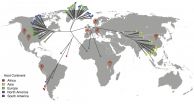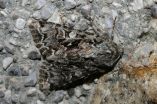Humans responsible for demise of gigantic ancient mammals
Early humans were the dominant cause of the extinction of a variety of species of giant beasts, new research has revealed
2015-08-13
(Press-News.org) Early humans were the dominant cause of the extinction of a variety of species of giant beasts, new research has revealed.
Scientists at the universities of Exeter and Cambridge claim their research settles a prolonged debate over whether mankind or climate change was the dominant cause of the demise of massive creatures in the time of the sabretooth tiger, the woolly mammoth, the woolly rhino and the giant armadillo.
Known collectively as megafauna, most of the largest mammals ever to roam the earth were wiped out over the last 80,000 years, and were all extinct by 10,000 years ago.
Lewis Bartlett, of the University of Exeter, led the research, which also involved the universities of Reading and Bristol and is published in the journal Ecography. He said cutting-edge statistical analysis had helped solve the mystery almost beyond dispute, concluding that man was the dominant force in wiping out the creatures, although climate change could also have played a lesser role.
The researchers ran thousands of scenarios which mapped the windows of time in which each species is known to have become extinct, and humans are known to have arrived on different continents or islands. This was compared against climate reconstructions for the last 90,000 years.
Examining different regions of the world across these scenarios, they found coincidences of human spread and species extinction which illustrate that man was the main agent causing the demise, with climate change exacerbating the number of extinctions. However, in certain regions of the world - mainly in Asia - they found patterns which patterns were broadly unaccounted for by either of these two drivers, and called for renewed focus on these neglected areas for further study.
Lewis Bartlett, a researcher from the University of Exeter's Centre for Ecology and Conservation, said: "As far as we are concerned, this research is the nail in the coffin of this 50-year debate - humans were the dominant cause of the extinction of megafauna. What we don't know is what it was about these early settlers that caused this demise. Were they killing them for food, was it early use of fire or were they driven out of their habitats? Our analysis doesn't differentiate, but we can say that it was caused by human activity more than by climate change. It debunks the myth of early humans living in harmony with nature."
Dr Andrea Manica, of Cambridge University, was lead supervisor on the paper. He said: "Whilst our models explain very well the timing and extent of extinctions for most of the world, mainland Asia remains a mystery. According to the fossil record, that region suffered very low rates of extinctions. Understanding why megafauna in mainland Asia is so resilient is the next big question."
INFORMATION:
ELSE PRESS RELEASES FROM THIS DATE:
2015-08-13
The discovery of antidepressant drugs in the 1950s led to the first biochemical hypothesis of depression, known as the monoamine hypothesis. This hypothesis proposes that an imbalance of certain brain chemicals is the key cause of depression. Research has investigated whether and to what degree the "reward and pleasure" chemical dopamine and, more recently, the "happiness" chemical serotonin, could be the neurotransmitters involved in the malady. However, the monoamine hypothesis does not seem to fully explain the complexity of human depression. Now a new study offers one ...
2015-08-13
August 13, 2015--A visit to the dentist has the potential to be more than a checkup of our teeth as patients are increasingly screened for medical conditions like heart disease and diabetes. A new study by researchers at Columbia University's Mailman School of Public Health focuses on dental screenings for drug misuse, finding 77 percent of dentists ask patients about illicit drug use, and 54 percent of dentists believe that such screenings should be their responsibility. Results of the study are online in the journal Addiction.
"There are a sizeable number of people ...
2015-08-13
TORONTO, (Aug. 13, 2015) - Low birth weight and preterm birth appear to increase the risk of schizophrenia among individuals with a genetic condition called the 22q11.2 deletion syndrome, a new study from the Centre for Addiction and Mental Health (CAMH) shows.
The research, published in Genetics in Medicine, is "...part of ongoing efforts among schizophrenia researchers to predict and prevent illness at the earliest stages possible," says senior author Dr. Anne Bassett, Clinician-Scientist in CAMH's Campbell Family Mental Health Research Institute and Canada Research ...
2015-08-13
MANHATTAN, Kansas -- A Kansas State University biochemistry professor has reached a milestone in building a better biofuel: producing high levels of lipids with modified properties in oil seeds.
Timothy Durrett, assistant professor of biochemistry and molecular biophysics, and collaborators at Michigan State University and the University of Nebraska, Lincoln have modified Camelina sativa -- a nonfood oilseed crop -- and produced the highest levels of modified seed lipids to date. By modifying the oilseed biochemistry in camelina, the researchers have achieved very high ...
2015-08-13
CLEMSON, S.C. -- Parishioners who participate in small groups within a religious congregation are generally more likely to be civically engaged than their fellow worshipers unless a church has high overall small-group participation, according to research recently released by Clemson and Louisiana State universities.
The study, "Small groups, contexts, and civic engagement: A multilevel analysis of United States Congregational Life Survey data," published in the July issue of the journal Social Science Research, reveals that the positive effect small-group participation ...
2015-08-13
CORVALLIS, Ore. - A report concludes that blooms of toxic cyanobacteria, or blue-green algae, are a poorly monitored and underappreciated risk to recreational and drinking water quality in the United States, and may increasingly pose a global health threat.
Several factors are contributing to the concern. Temperatures and carbon dioxide levels have risen, many rivers have been dammed worldwide, and wastewater nutrients or agricultural fertilizers in various situations can cause problems in rivers, lakes and reservoirs.
No testing for cyanobacteria is mandated by state ...
2015-08-13
SEATTLE, WA, AUGUST 13, 2015 - Advances in the field of statistics are helping to unlock the mysteries of the human microbiome--the vast collection of microorganisms living in and on the bodies of humans, said Katherine Pollard, a statistician and biome expert, during a session today at the 2015 Joint Statistical Meetings (JSM 2015) in Seattle.
Pollard, senior investigator at the Gladstone Institutes and professor of epidemiology and biostatistics at the University of California, San Francisco, delivered a presentation titled "Estimating Taxonomic and Functional Diversity ...
2015-08-13
SEATTLE, WA, AUGUST 13, 2015 - The results of the first population survey of Mogadishu, Somalia, conducted in a quarter century were presented today at a session of the 2015 Joint Statistical Meetings (JSM 2015) in Seattle.
Jesse Driscoll, assistant professor of political science at the University of California, San Diego, presented the results in an invited presentation titled "Representative Surveys in Insecure Environments: A Case Study of Mogadishu, Somalia."
The representative survey, conducted in March 2012, combined the use of smartphone technology and remote-sensing ...
2015-08-13
12.08.2015: When the western part of the super-continent Gondwana broke up around 130 Million years ago, today's Africa and South-America started to separate and the South Atlantic was born. It is commonly assumed that enormous masses of magma ascended from the deep mantle up to higher levels, and that this hot mantle plume (the Tristan mantle plume) weakened the continental lithosphere, eventually causing the break-up of the continental plate of Gondwana.
A group of German scientists are now questioning this theory. On the basis of seismic measurements published in ...
2015-08-13
This news release is available in German.
Kalmar/Halle(Saale). Why some species of plants and animals vary more in number than others is a central issue in ecology. Now researchers at Linnaeus University in Sweden and from the Helmholtz Centre for Environmental Research (UFZ) have found an important finding to answer this question: Individual differences have a positive and stabilizing effect on the number of moths. Species with varying colour drawing are generally more numerous and fluctuate less in number from year to year. The results were recently published ...
LAST 30 PRESS RELEASES:
[Press-News.org] Humans responsible for demise of gigantic ancient mammals
Early humans were the dominant cause of the extinction of a variety of species of giant beasts, new research has revealed


